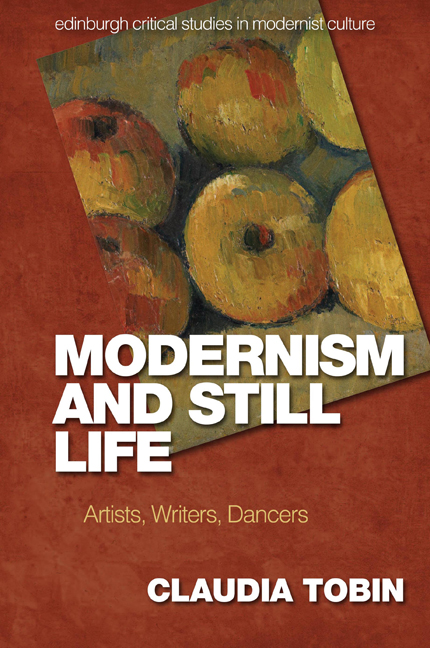Book contents
- Frontmatter
- Contents
- List of Figures and Plates
- List of Abbreviations
- Acknowledgements
- Series Editors’ Preface
- Introduction: ‘Nothing is really statically at rest’: Cézanne and Modern Still Life
- 1 ‘Quivering yet still’: Virginia Woolf, Roger Fry and the Aesthetics of Attention
- 2 Still Life in Motion
- 3 ‘Past the gap where we cannot see’: Still Life and the ‘Numinous’ in British Painting of the 1920s–1930s
- 4 ‘Inactive contemplation’: Wallace Stevens and Charles Mauron
- Conclusion: ‘On the very brink of utterance’: Aldous Huxley, Mark Gertler and Transfigured Things
- Bibliography
- Index
- Plate Section
4 - ‘Inactive contemplation’: Wallace Stevens and Charles Mauron
Published online by Cambridge University Press: 08 October 2020
- Frontmatter
- Contents
- List of Figures and Plates
- List of Abbreviations
- Acknowledgements
- Series Editors’ Preface
- Introduction: ‘Nothing is really statically at rest’: Cézanne and Modern Still Life
- 1 ‘Quivering yet still’: Virginia Woolf, Roger Fry and the Aesthetics of Attention
- 2 Still Life in Motion
- 3 ‘Past the gap where we cannot see’: Still Life and the ‘Numinous’ in British Painting of the 1920s–1930s
- 4 ‘Inactive contemplation’: Wallace Stevens and Charles Mauron
- Conclusion: ‘On the very brink of utterance’: Aldous Huxley, Mark Gertler and Transfigured Things
- Bibliography
- Index
- Plate Section
Summary
The first words the artist seems to say to us are: ‘Look, listen, but don‘t move.‘
Charles Mauron[A] work of art is inaction.
Wallace StevensThe epigraphs above gesture toward a model of creative attention predicated on the opposition of stillness and movement. The French aesthetician, Charles Mauron (1899–1966), developed his theory of ‘inactive’ and ‘active’ contemplation in Aesthetics and Psychology, which was translated into English by Roger Fry, his friend and mentor, and published by Virginia and Leonard Woolf's Hogarth Press in 1935. Mauron's central concept in this text is the ‘aesthetic attitude’, which comes to signify an immobile state of suspended response and heightened receptivity. As the first epigraph from Mauron instructs us: ‘Look, listen, but don't move.’ The ‘aesthetic attitude‘ offers a paradigm for thinking about the art of still life and is a touchstone for this chapter. Mauron also provides an unexpected but suggestive nexus between the artists and writers of Bloomsbury and Wallace Stevens, who had been reading Aesthetics and Psychology in the mid-1930s. In this final chapter, I cross the Atlantic to explore the transmission of his ideas to the American poet.
Stevens made the inscription ‘a work of art is inaction’, at the beginning of the fifth chapter in his personal, annotated copy of Aesthetics and Psychology. It registers a symptomatic instance in which the poet echoes and compresses Mauron's appeal for an aesthetic of contemplative stillness. My inquiry departs from such fertile textual conjunctions to explore the ways in which the art of stillness and the (disputed) stillness of art, emerge as shared aesthetic and ontological concerns for the aesthetician and poet.
Stevens's library copy of Aesthetics and Psychology, which is now in the collection of the Huntington Library, California, offers a unique site through which to trace his encounter, or what is effectively a silent dialogue, with Mauron‘s theory of contemplative attention. From one's first contact with the worn paper cover, the book attests to thorough and responsive reading. The poet made frequent marginal annotations, underlined and marked out passages, and created a personal index on the flyleaf, signalling particular sections of interest.
- Type
- Chapter
- Information
- Modernism and Still LifeArtists, Writers, Dancers, pp. 160 - 202Publisher: Edinburgh University PressPrint publication year: 2020

